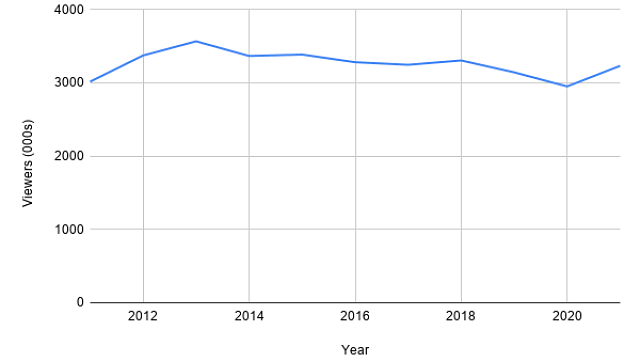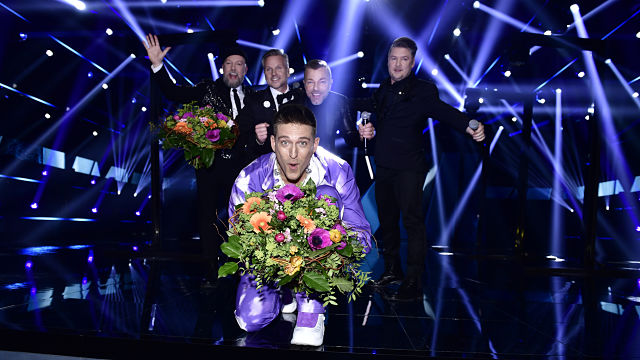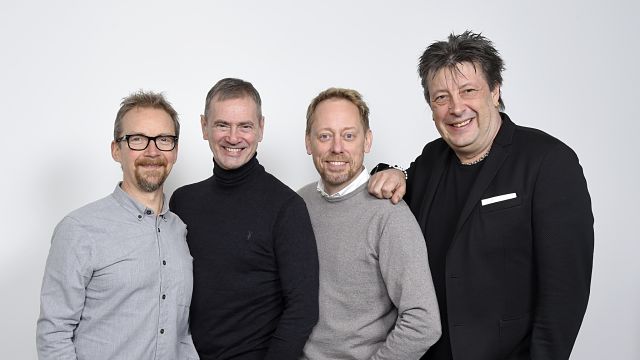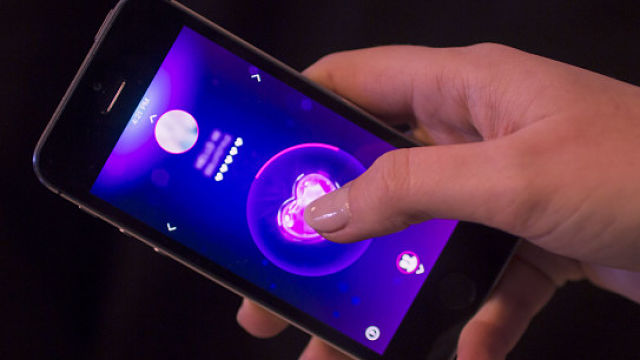In a pandemic hit year, with a world bound within their four walls, television viewing figures globally have increased. With this in mind there’s little surprise that the same applied to SVT’s flagship entertainment programme as Melodifestivalen kick started for the 2021 season.
Preliminary figures suggested there were 3.23 million viewers watching the first show live on SVT, with another 200,000 watching the show online. This marks a jump up in viewing figures from last year of just over 10%, reversing a steadily dropping trend, but is far below the record of over 3.5 million watching live on TV from 2013. Some quiet expectations of smashing this record didn’t come into fruition however.

Graph showing the number of viewers of Heat 1 in Melodifestivalen since 2011
That we were expecting a boost is no surprise. For a start this heat’s line up was stacked, with Swedish showbiz superstar Danny Saucedo in battle against two former Melodifestivalen winners. Furthermore we can note that SVT’s other top-of-the-ratings hit, their traditional Christmas showing of Disney cartoons, had over 4.5 million viewers and an increase of over a million from the previous year. We also look westwards towards Norway, which began the 2021 Melodi Grand Prix in January to much less fanfare, yet an audience boost more than SVT’s 10 percent.
The viewing figures are solid and worthy enough though for SVT to send out their own press release. However this is no new world record. What was startling though was just how engaged the Swedish viewers were.
Was There A Record Lurking
When SVT reveals the full breakdown of each heat’s result after the broadcast ends, there are two additional statistics revealed. The first is the amount of money raised to Radiohjälpen, the fundraising campaign co-ordinated through Sweden’s public service broadcasters, and viewers who televote can choose to spend extra and donate money while voting for their favourites.
During Saturday’s first heat a total of 825,405 kronor was donated to Radiohjälpen via televoting. This is the highest amount in a heat since 2019 when John Lundvik qualified, and the highest in a first heat since Loreen qualified in 2012 – both a good omen for qualifiers Danny Saucedo and Arvingarna in the Melodifestivalen televote next month. It is especially remarkable for this statistic to have increased so much in 2021 as more of the voting public have switched from televoting to using the Melodifestivalen app, which offers up to five votes per song for free.

Danny Saucedo and Arvingarna celebrating their qualification (Photo: Stina Stjernkvist, SVT)
That makes the statistic in the record breaking territory all the more remarkable. Since 2019 SVT have stopped revealing the total number of votes cast in the immediate aftermath of the show. Instead the new statistic shows the number of voters. This statistic is a far better measurement of viewer engagement as on the Melodifestivalen app many people will vote more than once.
The total revealed on Saturday was 628,624 unique voters. Now it may be possible that this is a slight overestimate, as some people may vote on the app and also vote on their phone, but comparatively it is a huge gain. Viewership may have only increased by 10%, but only twice in the eight heats since 2019 has this number simmered over half a million voters, and both of those occasions had the eventual Melodifestivalen winner taking part in. This jump from heat 1 last year (featuring ‘Move’ by The Mamas) to this year is a staggering 25%.
This is where the difference lies. The quantity of Melodifestivalen viewers has only increased by a small step, but the measures of their engagement have taken a giant leap. Assuming no duplicates it can be claimed that just shy of 20% of viewers engaged with a second screen during the broadcast, either to vote on the app or a phone.
Those levels of second-screen engagement are what is record breaking.
Second Screen Engagement And Melodifestivalen’s Success
It will be little surprise I am sure to readers of ESC Insight that in the current age using a second screen while watching live television is now the norm; a behaviour that most people engage with. Most common behaviours include finding out more information about the show on television or engaging with friends or social media. These numbers are way more than the above mentioned 20%.
What appears to be unique in Melodifestivalen’s case is the interaction directly with the show, rather than through different platforms. An equivalent statistic looking at interaction with second screens during the 2018 FIFA World Cup found that only 15% of second screen users were using it to interact with the program itself, and for that survey just 51% of viewers were using second screens at all. Another example to compare is the British version of X Factor, with an app similar in scope and usage to what Melodifestivalen has as both offer free votes as their primary draw. In 2018 the final of X Factor had a peak of 7.5 million viewers tuning in with ‘over 1 million downloads’ of its app. If we make what I assume would be a huge overestimate that all one million people were active on the app during the final, that would be a usage percentage of just 13%, well below Melodifestivalen’s figure.
Now I can’t flick through my nearest Guinness Book of World Records to find a verified world record, but there’s only one time where I could maybe see this figure being matched. Last year’s Melodifestivalen final. In Friends Arena last year there were a record number of voters at 844,982. Yet we must caveat that with an increased viewing figure and songs more loved after weeks of airplay. Should the number of voters keep this trend up throughout the 2021 season we can realistically expect the seven figure mark to be surpassed by the final.
Going Back To The App’s Launch
To understand what makes the Melodifestivalen app so special I speak to Anders Lenhoff. Anders was the producer of Melodifestivalen back in 2015, the year that the Melodifestivalen app was first released. The launch in 2015 created a complete shift in how voting in Melodifestivalen worked, and proved to be so popular that the app crashed during the final that year.

Anders Lenhoff (left) with Christer Björkman, Peter Settman and Ola Melzig, the team behind the vision of the American Song Contest
At the time the expectation was that such an app would get an engagement rate of between 2-3%. By a factor of ‘many’, Lenhoff explains, the production team underestimated the demand that viewers would have for the new app. Lenhoff reasoned that the main motivation for the app’s early popularity was the ability to have free votes. Many of Lenhoff’s friends have since explained to him how this helped limit their children’s voting, rather than them pleading to vote again and again at their parents’ expense.
The ability to vote for free is the main driving force behind the app’s success, yet those features exist in shows like The Voice and The X Factor without the same engagement. Lendoff praised the work of the app developers since that 2015 launch to provide more functionality and gamification features that both connect people together and hook them into the experiences. Examples include the ability to collect character cards and tip each round, as well as creating an avatar and gaining trophies for completing certain tasks (such as voting for an entry qualifying to the final). Furthermore the app has taken over the function of the now-removed SVT Melodifestivalen homepage as the source of news and information, and it was via here that news on each artist announcement was revealed last December.

Viewers need to ‘button-bash’ the heart symbol to vote for their favourites during the show
First Sweden, Now America
Anders Lenhoff’s role today is a different one. He is one of the team hoping to take the Eurovision Song Contest over to America, with a vision set out for all 50 states to compete against each other in an ‘American Song Contest’. The success of the Melodifestivalen app, Lenhoff claims, is “one of the big selling points” in the move to take the concept stateside.
The magic behind these sky high engagement numbers is partly the app’s design and the variety of ways that it reels in users, however part of the magic is the competition itself. Anders rightly asks the question “why is it [Eurovision] so successful when other formats are in decline?” His answer, and what he explains is the “mantra” of the team behind the American Song Contest, is that behind the glitz and glamour Eurovision is a sporting event.
In a way that you don’t have with The X Factor that’s the sense of national pride and constant speculation that makes the big event unmissable. Lenhoff recalled memories to me of 1974, and having ABBA’s victory in Brighton on par with Sweden’s Davis Cup victory the same year as a moment that developed his pride in what Sweden could achieve.
And in that sense the Melodifestivalen app replicates so much that is iconic with being a sports fan. There is the ability to predict the result and share that with friends and speculate through all the twists and turns of rehearsals. There’s also the chance to collect cards of your favourites and trade them with others, creating new friendships just like Panini stickers achieved.
But there’s one advantage that the Song Contest has over sport. You as a viewer have a direct way to influence the result of the competition. Cheering for your favourites is one thing, but voting for who you want to win gives a whole new deeper connection with the show.
Has all of this meant SVT and their Melodifestivalen App have smashed a world record? Sadly I can’t verify this, but the claim that this level of engagement is world-leading appears to be fully valid. The Melodifestivalen app has been one factor in keeping this show on the up when others are in decline and is a model that not just other European countries should be following closely, but for all entertainment and live event television around the globe.










I count for 2 of those online streamers. I have Apple TV (SVT’s app) on the big screen and also providing sound, but I also stream it again on the laptop using Google Chrome to auto-translate the subtitles.